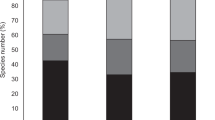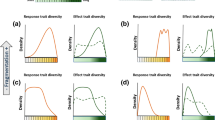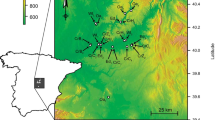Abstract
Context
Studying communities using a trait-based approach has contributed to major advances in the understanding of community assembly mechanisms, but research has primarily focused on the effect of local biotic and abiotic processes on plant assemblages.
Objectives
At the landscape level, we expect that the diversity of trait values (i.e. functional diversity) in plant assemblages is not random because there might be strong environmental constraints occurring as a filter of plant species at this level. We expect that fragmentation, through connectivity loss, may reduce functional diversity by filtering plant dispersal traits within the global pool of species toward those that present the trait values that are the most adapted. We tested this hypothesis at the metacommunity level and focused on ditch plant dispersal traits.
Methods
We characterised the functional diversity of 27 ditch bank metacommunities for three seed traits encompassing the whole dispersal process: production, buoyancy and mass. We computed four connectivity variables based on the ditch networks surrounding each metacommunity. Null models were designed to quantify functional convergence (i.e. convergence of the trait values around a mean) or divergence for each trait (i.e. dissimilarity in plant trait values).
Result
At the metacommunity level, we demonstrate that (1) connectivity loss reduces the functional diversity of dispersal traits (seed production and seed buoyancy), leading to the convergence of trait values, whereas more connected landscapes promote randomness, or even divergence (seed mass) in trait values; (2) these changes are due to the modification in the number of occurrence of plant species over the nine local communities sampled, rather than in species identity.
Conclusions
Our results indicated that, at the metacommunity level, reduced connectivity acts as a filter on the dispersal traits of plant species, promoting the broad distribution of species with efficient dispersal abilities in such landscapes. Thus, functional diversity helps us to understand the mechanisms underlying the effects of fragmentation on biodiversity.



Similar content being viewed by others
References
Adler PB, Fajardo A, Kleinhesselink AR, Kraft NJB (2013) Trait-based tests of coexistence mechanisms. Ecol Lett 16:1294–1306
Akaike H (1974) A new look at the statistical model identification. IEEE Trans Autom Control 19:716–723
Alignier A, Bretagnolle V, Petit S (2012) Spatial patterns of weeds along a gradient of landscape complexity. Basic Appl Ecol 13:328–337
Amarasekare P (2003) Competitive coexistence in spatially structured environments: a synthesis. Ecol Lett 6:1109–1122
Bennett JA, Lamb EG, Hall JC, Cardinal-McTeague WM, Cahill JF Jr (2013) Increased competition does not lead to increased phylogenetic overdispersion in a native grassland. Ecol Lett 16:1168–1176
Bernard-Verdier M, Navas ML, Vellend M, Violle C, Fayolle A, Garnier E (2012) Community assembly along a soil depth gradient: contrasting patterns of plant trait convergence and divergence in a Mediterranean rangeland. J Ecol 100:1422–1433
Boedeltje G, Bakker JP, Bekker RM, Van Groenendael JM, Soesbergen M (2003) Plant dispersal in a lowland stream in relation to occurrence and three specific life-history traits of the species in the species pool. J Ecol 91:855–866
Bruno JF, Stachowicz JJ, Bertness MD (2003) Inclusion of facilitation into ecological theory. Trends Ecol Evol 18:119–125
Burnham K, Anderson DR (2002) Model selection and multimodel inference: a practical information-theoretic approach, 2nd edn. Springer, New York
Chang ER, Veeneklaas RM, Buitenwerf R, Bakker JP, Bouma TJ (2008) To move or not to move: determinants of seed retention in a tidal marsh. Funct Ecol 22:720–727
Cornelissen JHC, Lavorel S, Garnier E, Díaz S, Buchmann N, Gurvich DE, Reich PB, ter Steege H, Morgan HD, van der Heijden MGA, Pausa JG, Poorter H (2003) A handbook of protocols for standardised and easy measurement of plant functional traits worldwide. Aust J Bot 51:335–380
Damschen EI, Brudvig LA, Haddad NM, Levey DJ, Orrock JL, Tewksbury JJ (2008) The movement ecology and dynamics of plant communities in fragmented landscapes. Proc Natl Acad Sci USA 105:19078–19083
De Bello F (2012) The quest for trait convergence and divergence in community assembly: are null-models the magic wand? Glob Ecol Biogeogr 21:312–317
De Bello F, Leps J, Sebastia MT (2006) Variations in species and functional plant diversity along climatic and grazing gradients. Ecography 29:801–810
Diaz S, Lavorel S, McIntyre S, Falczuk V, Casanoves F, Milchunas DG, Skarpe C, Rusch G, Sternberg M, Noy-Meir I, Landsberg J, Zhang W, Clark H, Campbell BD (2007) Plant trait responses to grazing—a global synthesis. Glob Chang Biol 13:313–341
Duflot R, Georges R, Ernoult A, Aviron S, Burel F (2014) Landscape heterogeneity as an ecological filter of species traits. Acta Oecologica 56:19–26
Eriksson O (1992) Evolution of seed dispersal and recruitment in clonal plants. Oikos 63:439–448
Fahrig L (2003) Effects of habitat fragmentation on biodiversity. Annu Rev Ecol Evol Syst 34:487–515
Favre-Bac L, Ernoult A, Mony C, Rantier Y, Nabucet J, Burel F (2014) Connectivity and propagule sources composition drive ditch plant metacommunity structure. Acta Oecol 61:57–64
Gotelli NJ, McCabe DJ (2002) Species co-occurrence: a meta-analysis of JM Diamond’s assembly rules model. Ecology 83:2091–2096
Grime JP (2006) Trait convergence and trait divergence in herbaceous plant communities: mechanisms and consequences. J Veg Sci 17:255–260
Helsen K, Ceulemans T, Stevens CJ, Honnay O (2014) Increasing soil nutrient loads of European semi-natural grasslands strongly alter plant functional diversity independently of species loss. Ecosystems 17:169–181
Herben T, Goldberg DE (2014) Community assembly by limiting similarity vs. competitive hierarchies: testing the consequences of dispersion of individual traits. J Ecol 102(1):56–166
Hughes L, Dunlop M, French K, Leishman MR, Rice B, Rodgerson L, Westoby M (1994) Predicting dipersal spectra: a minimal set of hypotheses based on plant attributes. J Ecol 82:933–950
Hulvey KB, Aigner PA (2014) Using filter-based community assembly models to improve restoration outcomes. J Appl Ecol 51(4):997–1005
Hurvich CM, Tsai CL (1989) Regression and time series model selection in small samples. Biometrika 76:297–307
Jackson ST, Sax DF (2010) Balancing biodiversity in a changing environment: extinction debt, immigration credit and species turnover. Trends Ecol Evol 25(3):153–160
Jones NT, Germain RM, Grainger TN, Hall AM, Baldwyn L, Gilbert B (2015) Dispersal modes mediates the effect of patch size and patch connectivity on metacommunity diversity. J Ecol 103:935–944
Keddy PA (1992) Assembly and response rules—2 goals for predictive community ecology. J Veg Sci 3:157–164
Kleyer M, Bekker RM, Knevel IC (2008) The LEDA Traitbase: a database of life-history traits of the Northwest European flora. J Ecol 96:1266–1274
Kühn I, Durka W, Klotz S (2004) BiolFlor—a new plant-trait database as a tool for plant invasion ecology. Divers Distrib 10:363–365
Kunstler G, Lavergne S, Courbaud B, Thuiller W, Vieilledent G, Zimmermann NE, Kattge J, Coomes DA (2012) Competitive interactions between forest trees are driven by species’ trait hierarchy, not phylogenetic or functional similarity: implications for forest community assembly. Ecol Lett 15:831–840
Kuussaari M, Bommarco R, Heikkinen RK, Helm A, Krauss J, Lindbor R, Öckinger E, Pärtel M, Pino J, Rodà F, Stefanescu C, Teder T, Zobel M, Steffan-Dewenter I (2009) Extinction debt: a challenge for biodiversity conservation. Trends Ecol Evol 24:564–571
Laliberté E, Legendre P (2010) A distance-based framework for measuring functional diversity from multiple traits. Ecology 91:299–305
Laliberté E, Wells JA, DeClerck F, Metcalfe DJ, Catterall CP, Queiroz C, Aubin I, Bonser SP, Ding Y, Fraterrigo JM, McNamara S, Morgan JW, Sánchez Merlos D, Vesk PA, Mayfield MM (2010) Land-use intensification reduces functional redundancy and response diversity in plant communities. Ecol Lett 13:76–86
Leibold MA, Holyoak M, Mouquet N, Amarasekare P, Chase JM, Hoopes MF, Holt RD, Shurin JB, Law R, Tilman D, Loreau M, Gonzalez A (2004) The metacommunity concept: a framework for multi-scale community ecology. Ecol Lett 7:601–613
Levey DJ, Tewksbury JJ, Bolker BM (2008) Modelling long-distance seed dispersal in heterogeneous landscapes. J Ecol 96:599–608
Lortie CJ, Brooker RW, Choler P, Kikvidze Z, Michalet R, Pugnaire FI, Callaway RM (2004) Rethinking plant community theory. Oikos 107:433–438
MacArthur R, Levins R (1967) The limiting similarity, convergence, and divergence of coexisting species. Am Nat 101:377–385
Mason NWH, de Bello F, Mouillot D, Pavoine S, Dray S (2013) A guide for using functional diversity indices to reveal changes in assembly processes along ecological gradients. J Veg Sci 24:794–806
Mason NWH, Lanoiselée C, Mouillot D, Wilson JB, Argillier C (2008) Does niche overlap control relative abundance in French lacustrine fish communities? A new method incorporating functional traits. J Anim Ecol 77:661–669
Mayfield MM, Ackerly D, Daily GC (2006) The diversity and conservation of plant reproductive and dispersal functional traits in human-dominated tropical landscapes. J Ecol 94:522–536
Mayfield MM, Bonser SP, Morgan JW, Aubin I, McNamara S, Vesk PA (2010) What does species richness tell us about functional trait diversity? Predictions and evidence for responses of species and functional trait diversity to land-use change. Glob Ecol Biogeogr 19:423–431
Meszéna G, Gyllenberg M, Pasztor L, Metz JAJ (2006) Competitive exclusion and limiting similarity: a unified theory. Theor Popul Biol 69:68–87
Miller JED, Damschen EI, Harrison SP, Grace JB (2015) Landscape structure affects specialists but not generalists in naturally fragmented grasslands. Ecology 96:3323–3331
Mouchet MA, Villéger S, Mason NWH, Mouillot D (2010) Functional diversity measures: an overview of their redundancy and their ability to discriminate community assembly rules. Funct Ecol 24:867–876
Mouquet N, Miller TE, Daufresne T, Kneitel JM (2006) Consequences of varying regional heterogeneity in source sink metacommunities. Oikos 113:481–488
Nathan R, Muller-Landau HC (2000) Spatial patterns of seed dispersal, their determinants and consequences for recruitment. Trends Ecol Evol 15:278–285
Nilsson C, Brown RL, Jansson R, Merritt DM (2010) The role of hydrochory in structuring riparian and wetland vegetation. Biol Rev Camb Philos Soc 85:837–858
Pacala SW, Tilman D (1994) Limiting similarity in mechanistic and spatial models of plant competition in heterogenous environments. Am Nat 143:222–257
Price JN, Pärtel M (2013) Can limiting similarity increase invasion resistance? A meta-analysis of experimental studies. Oikos 122:649–656
Purschke O, Sykes MT, Poschlod P, Michalski SG, Römermann C, Durka W, Kühn I, Prentice HC (2014) Interactive effects of landscape history and current management on dispersal trait diversity in grassland plant communities. J Ecol 102:437–446
Rao CR (1982) Diversity and dissimilarity coefficients—a unified approach. Theor Popul Biol 21:24–43
Ricotta C (2005) A note on functional diversity measures. Basic Appl Ecol 6:479–486
Schneider RL, Sharitz RR (1988) Hydrochory and retention in a bald cypress-water tupelo swamp forest. Ecology 69:1055–1063
Soomers H, Winkel DN, Du Y, Wassen MJ (2010) The dispersal and deposition of hydrochorous plant seeds in drainage ditches. Freshw Biol 55:2032–2046
Stöcklin J, Winkler E (2004) Optimum reproduction and dispersal strategies of a clonal plant in a metapopulation: a simulation study with Hieracium pilosella. Evol Ecol 18:563–584
Thompson K, Rickard LC, Hodkinson DJ, Rees M (2002) Seed dispersal: the search for trade-offs. In: Bullock JM, Kenward RE, Hails RS (eds) Dispersal ecology. Blackwell, Oxford
Van der Valk AG (1981) Succession in wetlands: a Gleasonian approach. Ecology 62:688–696
van Kleunen M, Fischer M, Schmid B (2002) Experimental life-history evolution: selection on the allocation to sexual reproduction and its plasticity in a clonal plant. Evolution 56:2168–2177
Vittoz P, Engler R (2007) Seed dispersal distances: a typology based on dispersal modes and plant traits. Bot Helv 117:109–124
Weiher E, Keddy PA (1995) The assembly of experimental wetland plant communities. Oikos 73:323–335
Wilson DS (1992) Complex interactions in metacommunities, with implications for biodiversity and higher levels of selection. Ecology 73:1984–2000
Winegardner AK, Jones BK, Ng ISY, Siqueira T, Cottenie K (2012) The terminology of metacommunity ecology. Trends Ecol Evol 27(5):253–254
Acknowledgements
The authors are grateful to Jean-Louis Wattez and Céline Wattez for logistical help and fieldwork organisation, Justine Berthoux, Mélanie Cosquer, Pauline Defives, Renaud Demarle, Fréderi Bac, Annick De Jonckheere, Alain De Jonckheere, Monique Farda, Jean-Philippe Robert and Yves Mannessier for their participation to the field surveys. We also thank Eric Petit for helpful statistical advices. This research was funded by the Nord—Pas de Calais region (CorEcol project).
Author information
Authors and Affiliations
Corresponding author
Electronic supplementary material
Below is the link to the electronic supplementary material.
Rights and permissions
About this article
Cite this article
Favre-Bac, L., Mony, C., Burel, F. et al. Connectivity drives the functional diversity of plant dispersal traits in agricultural landscapes: the example of ditch metacommunities. Landscape Ecol 32, 2029–2040 (2017). https://doi.org/10.1007/s10980-017-0564-1
Received:
Accepted:
Published:
Issue Date:
DOI: https://doi.org/10.1007/s10980-017-0564-1




